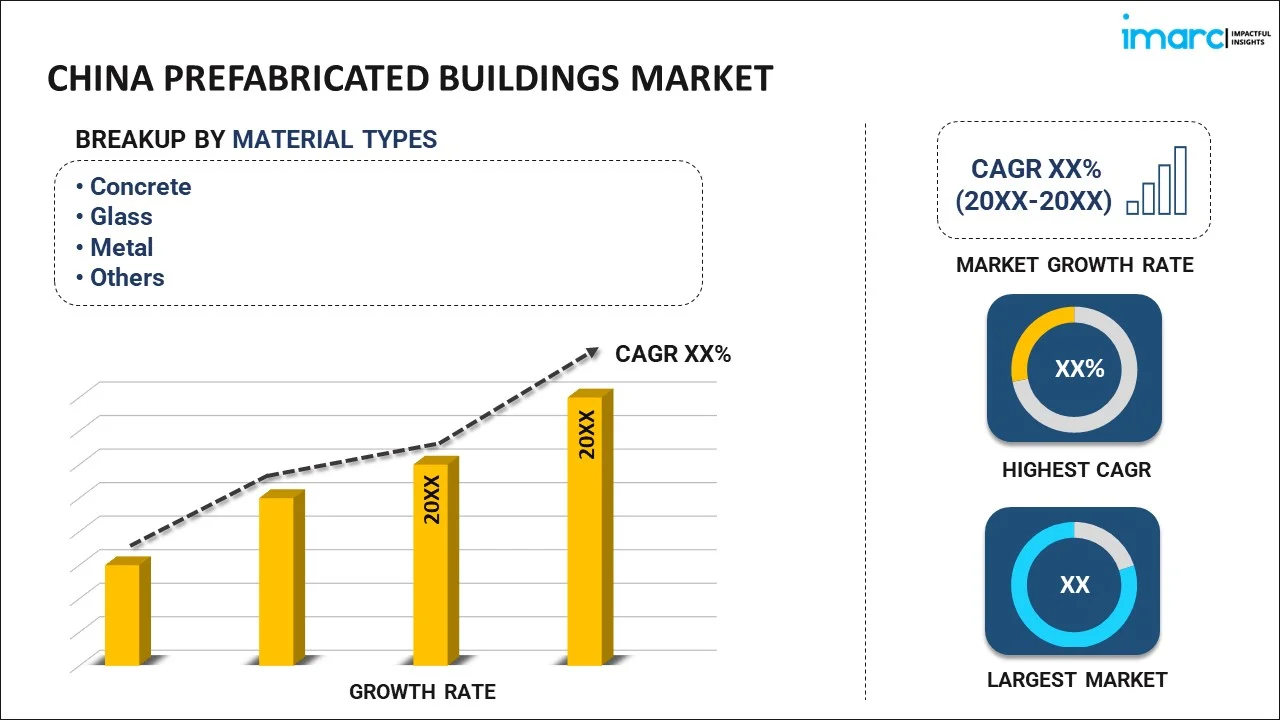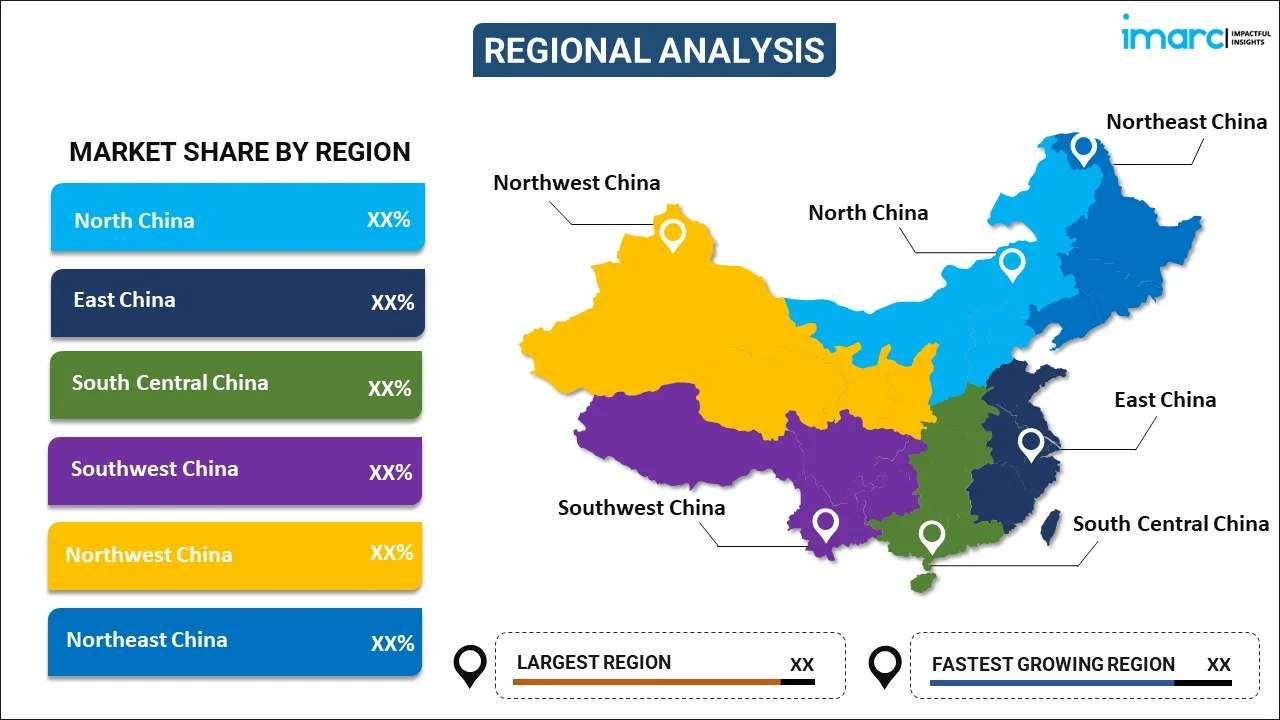
China Prefabricated Buildings Market Report by Material Type (Concrete, Glass, Metal, Timber, and Others), Application (Residential, Commercial, and Others), and Region 2025-2033
Market Overview:
China prefabricated buildings market size is projected to exhibit a growth rate (CAGR) of 4.80% during 2025-2033. Continuous innovations and customization in architectural designs are primarily augmenting the market growth across the country.
|
Report Attribute
|
Key Statistics
|
|---|---|
|
Base Year
|
2024 |
|
Forecast Years
|
2025-2033 |
|
Historical Years
|
2019-2024
|
| Market Growth Rate (2025-2033) | 4.80% |
Prefabricated buildings, commonly known as prefab or modular buildings, are structures manufactured off-site in sections or modules and assembled on the construction site. They are designed and produced in a controlled factory environment, using precise engineering and advanced manufacturing techniques. The components are then transported to the construction site, where they are assembled to create a complete structure. Prefabricated buildings can serve a variety of purposes, including residential, commercial, and industrial applications. They offer advantages such as faster construction timelines, cost-effectiveness, and reduced environmental impact, as materials are optimized, and waste is minimized during the manufacturing process. These buildings can be tailored to meet specific design requirements and are increasingly popular for their efficiency, sustainability, and flexibility in meeting diverse construction needs.
China Prefabricated Buildings Market Trends:
The prefabricated buildings market in China is experiencing significant momentum, driven by contemporary factors and emerging trends. A primary driver is the growing demand for rapid and efficient construction solutions in response to the country's urbanization and infrastructure development goals. Moreover, prefabricated buildings offer accelerated construction timelines, reducing on-site labor requirements and overall project durations. Besides this, the increasing focus on eco-friendly and energy-efficient prefab structures is propelling the market growth across the country. Furthermore, the elevating use of sustainable materials and construction processes is acting as another significant growth-inducing factor. Apart from this, technological innovation is influencing the market in China, with advancements in design software, modular construction techniques, and integrated smart technologies. These innovations enhance precision, customization, and overall efficiency in the production and assembly of prefabricated buildings. Additionally, government initiatives and policies supporting prefabrication as a viable construction method are further propelling the market growth across the country. With the rising focus on quality, safety, and efficiency, these policies encourage the adoption of prefabricated solutions across various sectors, including residential, commercial, and public infrastructures. In conclusion, these drivers and trends collectively address the evolving construction needs in the country, which is anticipated to fuel the market growth over the forecasted period.
China Prefabricated Buildings Market Segmentation:
IMARC Group provides an analysis of the key trends in each segment of the market, along with forecasts at the country level for 2025-2033. Our report has categorized the market based on material type and application.
Material Type Insights:

- Concrete
- Glass
- Metal
- Timber
- Others
The report has provided a detailed breakup and analysis of the market based on the material type. This includes concrete, glass, metal, timber, and others.
Application Insights:
- Residential
- Commercial
- Others
A detailed breakup and analysis of the market based on the application have also been provided in the report. This includes residential, commercial, and others.
Regional Insights:

- North China
- East China
- South Central China
- Southwest China
- Northwest China
- Northeast China
The report has also provided a comprehensive analysis of all the major regional markets, which include North China, East China, South Central China, Southwest China, Northwest China, and Northeast China.
Competitive Landscape:
The market research report has also provided a comprehensive analysis of the competitive landscape in the market. Competitive analysis such as market structure, key player positioning, top winning strategies, competitive dashboard, and company evaluation quadrant has been covered in the report. Also, detailed profiles of all major companies have been provided.
China Prefabricated Buildings Market Report Coverage:
| Report Features | Details |
|---|---|
| Base Year of the Analysis | 2024 |
| Historical Period | 2019-2024 |
| Forecast Period | 2025-2033 |
| Units | Million USD |
| Scope of the Report | Exploration of Historical Trends and Market Outlook, Industry Catalysts and Challenges, Segment-Wise Historical and Future Market Assessment:
|
| Material Types Covered | Concrete, Glass, Metal, Timber, Others |
| Applications Covered | Residential, Commercial, Others |
| Regions Covered | North China, East China, South Central China, Southwest China, Northwest China, Northeast China |
| Customization Scope | 10% Free Customization |
| Post-Sale Analyst Support | 10-12 Weeks |
| Delivery Format | PDF and Excel through Email (We can also provide the editable version of the report in PPT/Word format on special request) |
Key Questions Answered in This Report:
- How has the China prefabricated buildings market performed so far and how will it perform in the coming years?
- What has been the impact of COVID-19 on the China prefabricated buildings market?
- What is the breakup of the China prefabricated buildings market on the basis of material type?
- What is the breakup of the China prefabricated buildings market on the basis of application?
- What are the various stages in the value chain of the China prefabricated buildings market?
- What are the key driving factors and challenges in the China prefabricated buildings?
- What is the structure of the China prefabricated buildings market and who are the key players?
- What is the degree of competition in the China prefabricated buildings market?
Key Benefits for Stakeholders:
- IMARC’s industry report offers a comprehensive quantitative analysis of various market segments, historical and current market trends, market forecasts, and dynamics of the China prefabricated buildings market from 2019-2033.
- The research report provides the latest information on the market drivers, challenges, and opportunities in the China prefabricated buildings market.
- Porter's five forces analysis assist stakeholders in assessing the impact of new entrants, competitive rivalry, supplier power, buyer power, and the threat of substitution. It helps stakeholders to analyze the level of competition within the China prefabricated buildings industry and its attractiveness.
- Competitive landscape allows stakeholders to understand their competitive environment and provides an insight into the current positions of key players in the market.
Need more help?
- Speak to our experienced analysts for insights on the current market scenarios.
- Include additional segments and countries to customize the report as per your requirement.
- Gain an unparalleled competitive advantage in your domain by understanding how to utilize the report and positively impacting your operations and revenue.
- For further assistance, please connect with our analysts.
 Inquire Before Buying
Inquire Before Buying
 Speak to an Analyst
Speak to an Analyst
 Request Brochure
Request Brochure
 Request Customization
Request Customization




.webp)




.webp)












